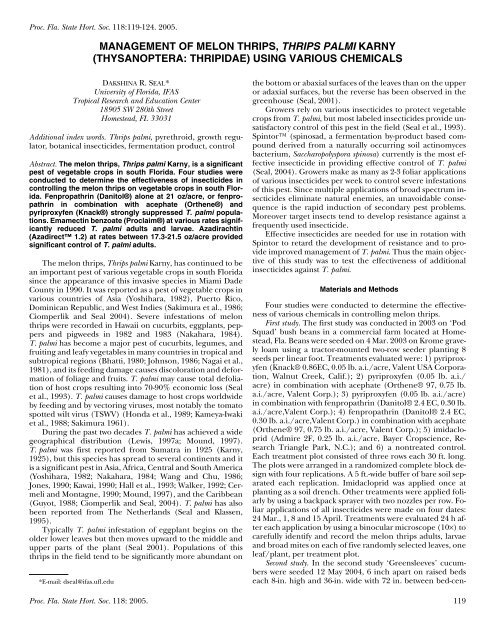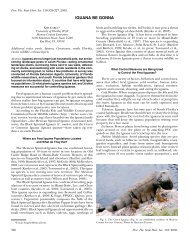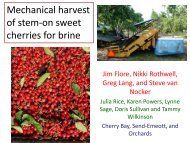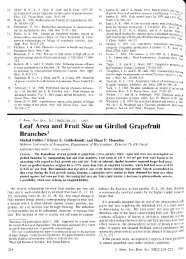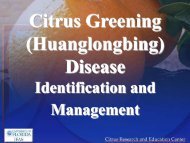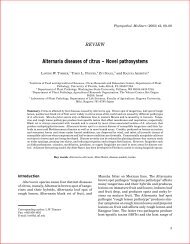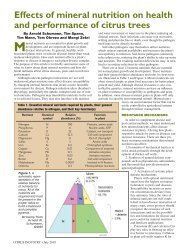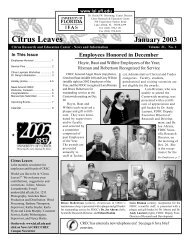management of melon thrips, thrips palmi karny - Citrus Research ...
management of melon thrips, thrips palmi karny - Citrus Research ...
management of melon thrips, thrips palmi karny - Citrus Research ...
Create successful ePaper yourself
Turn your PDF publications into a flip-book with our unique Google optimized e-Paper software.
Proc. Fla. State Hort. Soc. 118:119-124. 2005.<br />
MANAGEMENT OF MELON THRIPS, THRIPS PALMI KARNY<br />
(THYSANOPTERA: THRIPIDAE) USING VARIOUS CHEMICALS<br />
DAKSHINA R. SEAL*<br />
University <strong>of</strong> Florida, IFAS<br />
Tropical <strong>Research</strong> and Education Center<br />
18905 SW 280th Street<br />
Homestead, FL 33031<br />
Additional index words. Thrips <strong>palmi</strong>, pyrethroid, growth regulator,<br />
botanical insecticides, fermentation product, control<br />
Abstract. The <strong>melon</strong> <strong>thrips</strong>, Thrips <strong>palmi</strong> Karny, is a significant<br />
pest <strong>of</strong> vegetable crops in south Florida. Four studies were<br />
conducted to determine the effectiveness <strong>of</strong> insecticides in<br />
controlling the <strong>melon</strong> <strong>thrips</strong> on vegetable crops in south Florida.<br />
Fenpropathrin (Danitol®) alone at 21 oz/acre, or fenpropathrin<br />
in combination with acephate (Orthene®) and<br />
pyriproxyfen (Knack®) strongly suppressed T. <strong>palmi</strong> populations.<br />
Emamectin benzoate (Proclaim®) at various rates significantly<br />
reduced T. <strong>palmi</strong> adults and larvae. Azadirachtin<br />
(Azadirect 1.2) at rates between 17.3-21.5 oz/acre provided<br />
significant control <strong>of</strong> T. <strong>palmi</strong> adults.<br />
The <strong>melon</strong> <strong>thrips</strong>, Thrips <strong>palmi</strong> Karny, has continued to be<br />
an important pest <strong>of</strong> various vegetable crops in south Florida<br />
since the appearance <strong>of</strong> this invasive species in Miami Dade<br />
County in 1990. It was reported as a pest <strong>of</strong> vegetable crops in<br />
various countries <strong>of</strong> Asia (Yoshihara, 1982), Puerto Rico,<br />
Dominican Republic, and West Indies (Sakimura et al., 1986;<br />
Ciomperlik and Seal 2004). Severe infestations <strong>of</strong> <strong>melon</strong><br />
<strong>thrips</strong> were recorded in Hawaii on cucurbits, eggplants, peppers<br />
and pigweeds in 1982 and 1983 (Nakahara, 1984).<br />
T. <strong>palmi</strong> has become a major pest <strong>of</strong> cucurbits, legumes, and<br />
fruiting and leafy vegetables in many countries in tropical and<br />
subtropical regions (Bhatti, 1980; Johnson, 1986; Nagai et al.,<br />
1981), and its feeding damage causes discoloration and deformation<br />
<strong>of</strong> foliage and fruits. T. <strong>palmi</strong> may cause total defoliation<br />
<strong>of</strong> host crops resulting into 70-90% economic loss (Seal<br />
et al., 1993). T. <strong>palmi</strong> causes damage to host crops worldwide<br />
by feeding and by vectoring viruses, most notably the tomato<br />
spotted wilt virus (TSWV) (Honda et al., 1989; Kameya-Iwaki<br />
et al., 1988; Sakimura 1961).<br />
During the past two decades T. <strong>palmi</strong> has achieved a wide<br />
geographical distribution (Lewis, 1997a; Mound, 1997).<br />
T. <strong>palmi</strong> was first reported from Sumatra in 1925 (Karny,<br />
1925), but this species has spread to several continents and it<br />
is a significant pest in Asia, Africa, Central and South America<br />
(Yoshihara, 1982; Nakahara, 1984; Wang and Chu, 1986;<br />
Jones, 1990; Kawai, 1990; Hall et al., 1993; Walker, 1992; Cermeli<br />
and Montagne, 1990; Mound, 1997), and the Caribbean<br />
(Guyot, 1988; Ciomperlik and Seal, 2004). T. <strong>palmi</strong> has also<br />
been reported from The Netherlands (Seal and Klassen,<br />
1995).<br />
Typically T. <strong>palmi</strong> infestation <strong>of</strong> eggplant begins on the<br />
older lower leaves but then moves upward to the middle and<br />
upper parts <strong>of</strong> the plant (Seal 2001). Populations <strong>of</strong> this<br />
<strong>thrips</strong> in the field tend to be significantly more abundant on<br />
*E-mail: dseal@ifas.ufl.edu<br />
the bottom or abaxial surfaces <strong>of</strong> the leaves than on the upper<br />
or adaxial surfaces, but the reverse has been observed in the<br />
greenhouse (Seal, 2001).<br />
Growers rely on various insecticides to protect vegetable<br />
crops from T. <strong>palmi</strong>, but most labeled insecticides provide unsatisfactory<br />
control <strong>of</strong> this pest in the field (Seal et al., 1993).<br />
Spintor (spinosad, a fermentation by-product based compound<br />
derived from a naturally occurring soil actinomyces<br />
bacterium, Saccharopolyspora spinosa) currently is the most effective<br />
insecticide in providing effective control <strong>of</strong> T. <strong>palmi</strong><br />
(Seal, 2004). Growers make as many as 2-3 foliar applications<br />
<strong>of</strong> various insecticides per week to control severe infestations<br />
<strong>of</strong> this pest. Since multiple applications <strong>of</strong> broad spectrum insecticides<br />
eliminate natural enemies, an unavoidable consequence<br />
is the rapid induction <strong>of</strong> secondary pest problems.<br />
Moreover target insects tend to develop resistance against a<br />
frequently used insecticide.<br />
Effective insecticides are needed for use in rotation with<br />
Spintor to retard the development <strong>of</strong> resistance and to provide<br />
improved <strong>management</strong> <strong>of</strong> T. <strong>palmi</strong>. Thus the main objective<br />
<strong>of</strong> this study was to test the effectiveness <strong>of</strong> additional<br />
insecticides against T. <strong>palmi</strong>.<br />
Materials and Methods<br />
Four studies were conducted to determine the effectiveness<br />
<strong>of</strong> various chemicals in controlling <strong>melon</strong> <strong>thrips</strong>.<br />
First study. The first study was conducted in 2003 on ‘Pod<br />
Squad’ bush beans in a commercial farm located at Homestead,<br />
Fla. Beans were seeded on 4 Mar. 2003 on Krome gravely<br />
loam using a tractor-mounted two-row seeder planting 8<br />
seeds per linear foot. Treatments evaluated were: 1) pyriproxyfen<br />
(Knack® 0.86EC, 0.05 lb. a.i./acre, Valent USA Corporation,<br />
Walnut Creek, Calif.); 2) pyriproxyfen (0.05 lb. a.i./<br />
acre) in combination with acephate (Orthene® 97, 0.75 lb.<br />
a.i./acre, Valent Corp.); 3) pyriproxyfen (0.05 lb. a.i./acre)<br />
in combination with fenpropathrin (Danitol® 2.4 EC, 0.30 lb.<br />
a.i./acre,Valent Corp.); 4) fenpropathrin (Danitol® 2.4 EC,<br />
0.30 lb. a.i./acre,Valent Corp.) in combination with acephate<br />
(Orthene® 97, 0.75 lb. a.i./acre, Valent Corp.); 5) imidacloprid<br />
(Admire 2F, 0.25 lb. a.i./acre, Bayer Cropscience, <strong>Research</strong><br />
Triangle Park, N.C.); and 6) a nontreated control.<br />
Each treatment plot consisted <strong>of</strong> three rows each 30 ft. long.<br />
The plots were arranged in a randomized complete block design<br />
with four replications. A 5 ft.-wide buffer <strong>of</strong> bare soil separated<br />
each replication. Imidacloprid was applied once at<br />
planting as a soil drench. Other treatments were applied foliarly<br />
by using a backpack sprayer with two nozzles per row. Foliar<br />
applications <strong>of</strong> all insecticides were made on four dates:<br />
24 Mar., 1, 8 and 15 April. Treatments were evaluated 24 h after<br />
each application by using a binocular microscope (10×) to<br />
carefully identify and record the <strong>melon</strong> <strong>thrips</strong> adults, larvae<br />
and broad mites on each <strong>of</strong> five randomly selected leaves, one<br />
leaf/plant, per treatment plot.<br />
Second study. In the second study ‘Greensleeves’ cucumbers<br />
were seeded 12 May 2004, 6 inch apart on raised beds<br />
each 8-in. high and 36-in. wide with 72 in. between bed-cen-<br />
Proc. Fla. State Hort. Soc. 118: 2005. 119
ters. The soil was Krome gravely loam at the Tropical <strong>Research</strong><br />
and Education Center, Homestead, Fla. Two weeks<br />
prior to setting transplants the beds were fumigated with MC-<br />
33 (67% methyl bromide and 33% chloropicrin) at 220 lb/<br />
acre. Each bed was supplied with one drip irrigation line and<br />
covered with 1.5-mil thick black polyethylene mulch. Cucumber<br />
plants were drip-irrigated twice daily. Fertilizer (N-P-K<br />
mix) was applied at 200-50-240 lb/acre. Weeds were controlled<br />
by soil-incorporating trifluralin (Treflan EC, 24 lb/<br />
acre) at 10 d before planting, supplemented during the middle<br />
<strong>of</strong> the season with mechanical cultivation. The treatment<br />
plots consisted <strong>of</strong> three rows each 30 ft. long. The plots were<br />
arranged in a randomized complete block design with four<br />
replications. A 5 ft.-wide buffer <strong>of</strong> bare soil separated each<br />
replication. Treatments evaluated in this study were: 1) two<br />
rates <strong>of</strong> emamectin benzoate (Proclaim® 5%, 0.1 and 0.15 lb.<br />
a.i./acre, Syngenta Crop Protection, Greensboro, N.C.), 2)<br />
spinosad (Spintor 2SC, 0.11 lb. a.i./acre, Dow AgroSciences<br />
LLC, Indianapolis, Ind.), and 3) a nontreated control. All<br />
insecticides were applied to the foliage on three dates- 17, 27<br />
June and 6 July, 2004 using a backpack sprayer with two nozzles<br />
per row at 30 psi delivering 70 gal/acre. There was no<br />
phytotoxicity with any <strong>of</strong> the treatments. Evaluation <strong>of</strong> treatments<br />
was conducted 24 h after each application by collecting<br />
five randomly selected leaves, one leaf per plant per treatment<br />
plot. Leaves were placed in ziplock bags, transported to<br />
the laboratory and washed with 70% ethanol to separate <strong>melon</strong><br />
<strong>thrips</strong> adults and larvae.<br />
Third study. The third study was conducted in 2005 in a research<br />
plot at the Tropical <strong>Research</strong> and Education Center using<br />
‘Greensleeves’ cucumber as a host crop. All materials and<br />
methods involved in this study were as described in the second<br />
study in cucumber in 2004. The seven treatments evaluated in<br />
this study were: 1) two rates <strong>of</strong> azadirachtin (Aza-Direct<br />
1.2(%), 0.012 and 0.016 lb. a.i./acre, Gowan Company, Yuma,<br />
Ariz.); 2) imidacloprid (Admire 2F, 0.25 lb. a.i./acre, Bayer<br />
CropScience, <strong>Research</strong> Triangle Park, N.C.) at planting as a<br />
soil drench followed by foliar application <strong>of</strong> two rates <strong>of</strong> azadirachtin<br />
(Aza-Direct 1.2(%) at 0.012 and 0.016 lb. a.i./<br />
acre. 3) imidacloprid alone at 0.25 lb. a.i./acre as a soil<br />
drench at planting; 4) spinosad (Spintor 2SC, 0.13 lb. a.i./<br />
acre, Indianapolis, Ind.); and 5) a nontreated control.<br />
Fourth study. In the fourth study, eight treatments with various<br />
formulations <strong>of</strong> azadirachtin (Aza-Direct 1.2(%). Ecozin®<br />
3.0 and Neemix® 4.5) were evaluated to control T. <strong>palmi</strong><br />
on cucumber. ‘Greensleeves’ cucumber was seeded in a<br />
Krome gravely loam soil on 28 Mar. 2005. Crop <strong>management</strong><br />
and insecticide application and efficacy evaluation methods<br />
were as described in above studies using cucumber. Treatments<br />
evaluated in this study were: 1) three rates <strong>of</strong> azadirachtin<br />
(Aza-Direct 1.2 [%] 0.004, 0.006 and 0.012 lb. a.i./acre),<br />
2) four rates <strong>of</strong> azadirachtin (Ecozin® 3% EC, 0.009, 0.012,<br />
0.015 and 0.018 lb. a.i./acre) in combination with vegetable<br />
oil-surfactant (Amigo, 1% v/v, Loveland Industries, Colo.),<br />
3) azadirachtin (Neemix® 4.5, 0.009 lb. a.i.; Certis USA, Columbia,<br />
Md.), and 4) a nontreated control. Treatments were<br />
applied on five dates between 25 April and 24 May. Treatments<br />
were evaluated for degree <strong>of</strong> controlling <strong>of</strong> T. <strong>palmi</strong> 24<br />
h after each application, i.e., on 26 April, 2, 12, 19 and 23 May.<br />
Data Analysis. Data were analyzed using s<strong>of</strong>tware provided<br />
by Statistical Analysis System release 6.03 (SAS Institute, Inc.,<br />
Cary, NC; SAS Institute, 1988). General linear model procedures<br />
were used to perform analysis <strong>of</strong> variance. Means were<br />
separated by Duncan Multiple Range Test (DMRT) at the<br />
0.05 level.<br />
Results and Discussion<br />
The population abundance <strong>of</strong> the <strong>melon</strong> <strong>thrips</strong> was low<br />
during the first study. None <strong>of</strong> the insecticide treatments provided<br />
any reduction <strong>of</strong> <strong>melon</strong> <strong>thrips</strong> adults when compared<br />
with the nontreated control (Table 1). Knack® alone,<br />
Knack® plus Orthene®, and Knack® plus Danitol® provided<br />
control <strong>of</strong> <strong>melon</strong> <strong>thrips</strong> larvae when compared with the nontreated<br />
control (Table 2). Also Danitol® + Orthene® significantly<br />
reduced <strong>melon</strong> <strong>thrips</strong> larvae when compared with the<br />
nontreated control.<br />
In the second study on cucumber, Proclaim® and Spintor®<br />
treatments significantly reduced <strong>melon</strong> <strong>thrips</strong> adults<br />
and larvae (Table 3) when compared with the nontreated<br />
control (Table 4). Mean numbers <strong>of</strong> <strong>melon</strong> <strong>thrips</strong> adults and<br />
larvae did not differ between two rates <strong>of</strong> Proclaim®. Spintor®<br />
at 7 oz/acre provided superior reduction <strong>of</strong> <strong>melon</strong><br />
<strong>thrips</strong>.<br />
In the third study, Aza-Direct treatments significantly<br />
reduced <strong>melon</strong> <strong>thrips</strong> adults on cucumber on all sampling<br />
dates when compared with the nontreated control (Table 5).<br />
Aza-Direct alone did not reduce <strong>melon</strong> <strong>thrips</strong> larvae when<br />
compared with the control (Table 6). Aza-Direct at 21.5<br />
oz./acre preceded by Admire® at planting provided significant<br />
reduction <strong>of</strong> <strong>melon</strong> <strong>thrips</strong> larvae when compared with<br />
the nontreated control. Spintor® significantly reduced mel-<br />
Table 1. Mean numbers <strong>of</strong> Thrips <strong>palmi</strong> adults per 20-leaf sample <strong>of</strong> bush bean treated with various insecticides in 2003.<br />
Treatment<br />
Rate per acre<br />
Mean number <strong>of</strong> T. <strong>palmi</strong> adults<br />
25 Mar 03 2 Apr 03 9 Apr 03 16 Apr 03<br />
Overall<br />
mean<br />
Knack® 8 oz 2.40 a 0.80 a 0.55 a 0.45 a 1.05 a<br />
Knack® 8 oz 1.40 a 0.95 a 0.60 a 0.95 a 0.98 a<br />
Orthene®<br />
0.75 lb a.i.<br />
Knack® 8 oz 2.10 a 1.15 a 0.65 a 0.80 a 1.18 a<br />
Danitol®<br />
0.30 lb a.i.<br />
Danitol® 0.30 lb a.i. 2.35 a 1.30 a 0.55 a 0.45 a 1.16 a<br />
Orthene®<br />
0.75 lb a.i.<br />
Admire® 16 oz 1.60 a 1.20 a 0.80 a 0.55 a 1.05 a<br />
Control 2.00 a 1.45 a 0.80 a 0.45 a 1.18 a<br />
Means within a column followed by the same letter or no letter do not differ significantly (P > 0.05; DMRT).<br />
120 Proc. Fla. State Hort. Soc. 118: 2005.
Table 2. Mean numbers <strong>of</strong> Thrips <strong>palmi</strong> larvae per 20-leaf sample <strong>of</strong> beans treated with various insecticides in 2003.<br />
Treatment<br />
Rate per acre<br />
Mean number <strong>of</strong> T. <strong>palmi</strong> larvae<br />
25 Mar 03 2 Apr 03 9 Apr 03 16 Apr 03<br />
Overall<br />
mean<br />
Knack® 8 oz 4.00 b 2.90 b 1.05 b 1.20 a 2.29 bc<br />
Knack® 8 oz 3.50 b 1.50 c 0.85 b 0.95 ab 1.70 c<br />
Orthene®<br />
0.75 lb a.i.<br />
Knack® 8 oz 9.05 a 2.30 bc 1.15 b 1.05 ab 3.39 ab<br />
Danitol®<br />
0.30 lb a.i.<br />
Danitol® 0.30 lb a.i. 3.90 b 1.50 c 0.65 b 0.65 ab 1.68 c<br />
Orthene®<br />
0.75 lb a.i.<br />
Admire® 16 oz 7.40 a 1.70 c 0.95 b 0.40 b 2.61 bc<br />
Control 4.30 b 4.60 a 2.90 a 1.10 a 3.23 a<br />
Means within a column followed by the same letter do not differ significantly (P > 0.05; DMRT).<br />
Table 3. Mean numbers <strong>of</strong> Thrips <strong>palmi</strong> adults per 5-leaf sample <strong>of</strong> cucumber treated with various treatments, Spring 2004.<br />
Mean number <strong>of</strong> T. <strong>palmi</strong> adults/sample<br />
Treatment<br />
Rate per acre<br />
18 June 04 28 June 04 7 July 04<br />
Overall mean<br />
Proclaim® 1.56 gm 9.50 a 8.75 b 10.25 b 4.33 b<br />
Proclaim® 2.35 gm 3.25 a 5.50 b 7.50 b 3.64 b<br />
Spintor® 7.0 oz 0.25 b 0.50 a 0.25 c 1.00 c<br />
Control 9.75 a 14.25 a 17.00 a 6.39 a<br />
Means within a column followed by the same letter do not differ significantly (P > 0.05; DMRT).<br />
on <strong>thrips</strong> adults (Table 5) and larvae (Table 6). When adults<br />
and larvae are considered together, all treatments significantly<br />
reduced <strong>melon</strong> <strong>thrips</strong> adults and larvae when compared<br />
with the control (Table 7). However Admire® was ineffective<br />
in reducing <strong>melon</strong> <strong>thrips</strong> populations in the present study.<br />
In the fourth study, population abundance <strong>of</strong> <strong>melon</strong><br />
<strong>thrips</strong> on cucumber was medium at the initiation <strong>of</strong> this study.<br />
The various insecticide treatments did not reduce <strong>melon</strong><br />
<strong>thrips</strong> adults when compared with the nontreated control<br />
(Table 8). The mean numbers <strong>of</strong> <strong>melon</strong> <strong>thrips</strong> larvae were sig-<br />
Table 4. Mean numbers <strong>of</strong> Thrips <strong>palmi</strong> larvae per 5 leaf sample <strong>of</strong> cucumber treated with various treatments, Spring 2004.<br />
Mean number <strong>of</strong> T. <strong>palmi</strong> larvae/sample<br />
Treatment<br />
Rate per acre<br />
18 June 04 28 June 04 7 July 04<br />
Overall mean<br />
Proclaim® 3.2 oz 16.50 b 17.00 b 23.00 c 18.83 b<br />
Proclaim® 4.8 oz 11.25 b 11.50 b 17.00 c 13.25 b<br />
Spintor® 7.0 oz 1.50 c 0.50 c 0.75 d 0.92 c<br />
Control 44.50 a 39.25 a 39.00 a 40.92 a<br />
Means within a column followed by the same letter do not differ significantly (P > 0.05; DMRT).<br />
Table 5. Mean numbers <strong>of</strong> <strong>melon</strong> <strong>thrips</strong> adults per 3-leaf sample <strong>of</strong> cucumber treated with various insecticides.<br />
Mean number <strong>of</strong> <strong>melon</strong> <strong>thrips</strong> adults<br />
11 June 04 18 June 04 25 June 04 2 July 04<br />
Treatments<br />
Rate [oz]/acre<br />
Mean number <strong>of</strong> T. <strong>palmi</strong> adults/sample<br />
Overall mean<br />
Aza-Direct 17.3 25.25 a-c 12.75 b 12.50 c 13.00 b 15.87 b<br />
Aza-Direct 21.5 19.75 b-d 11.25 b 12.50 c 11.75 b 13.81 bc<br />
Admire® 16.0 18.00 cd 11.00 b 10.00 cd 10.75 b 12.44 bc<br />
Aza-Direct 17.3<br />
Admire 16.0 13.75 d 12.50 b 7.50 d 11.25 b 11.25 c<br />
Aza-Direct 21.5<br />
Admire® 16.0 28.25 ab 19.75 a 17.25 b 15.75 ab 20.25 a<br />
Spintor® 8.0 4.75 e 2.75 c 3.25 e 3.25 c 3.50 d<br />
Control 31.00 a 21.50 a 23.25 a 20.75 a 24.15 a<br />
Mean within a column followed by a same letter do not differ significantly (P > 0.05; DMRT).<br />
Proc. Fla. State Hort. Soc. 118: 2005. 121
Table 6. Mean numbers <strong>of</strong> <strong>melon</strong> <strong>thrips</strong> larvae per 3-leaf sample <strong>of</strong> cucumber treated with various insecticides.<br />
Mean number <strong>of</strong> T. <strong>palmi</strong> larvae/sample<br />
Treatments<br />
Rate [oz]/acre<br />
11 June 04 18 June 04 25 June 04 2 July 04<br />
Overall mean<br />
Aza-Direct 17.3 127.25 ab 67.75 ab 78.00 a 39.50 a 78.13 a<br />
Aza-Direct 21.5 103.25 ab 60.75 bc 63.75 ab 36.50 a 66.00 ab<br />
Admire® 16.0 89.75 ab 57.25 bc 61.25 ab 36.75 a 61.25 ab<br />
Aza-Direct 17.3<br />
Admire® 16.0 75.25 b 48.25 c 49.50 b 27.75 a 50.19 b<br />
Aza-Direct 21.5<br />
Admire® 16.0 120.25 ab 66.50 ab 81.25 a 39.25 a 76.81 a<br />
Spintor® 8.0 11.50 c 10.50 d 11.00 c 7.25 b 10.06 c<br />
Control 133.50 a 77.00 a 76.75 a 43.75 a 82.75 a<br />
Mean within a column followed by a same letter do not differ significantly (P > 0.05; DMRT).<br />
nificantly fewer in all treated plants on the first sampling date<br />
when compared with the nontreated control (Table 9). The<br />
mean numbers <strong>of</strong> larvae per sample had increased in all treatments<br />
by the second sampling date and did not differ from<br />
the control. By the third sampling date, Ecozin® at 10 oz/<br />
acre had significantly reduced mean numbers <strong>of</strong> <strong>melon</strong> <strong>thrips</strong><br />
larvae per sample when compared with the control; but did<br />
not in relation to the other insecticidal treatments. By the<br />
fourth and fifth sampling dates, the mean numbers <strong>of</strong> larvae<br />
per sample had become significantly fewer in all treatments<br />
compared with the control. Based on the seasonal mean, Ecozin®<br />
at 10 oz/acre and Aza Direct at 16 oz/acre significantly<br />
reduced T. <strong>palmi</strong> larvae when compared with the control<br />
(Table 9). When adults and larvae are considered together<br />
Table 7. Mean number <strong>of</strong> <strong>melon</strong> <strong>thrips</strong> (adult + larvae) per 3-leaf sample <strong>of</strong> cucumber treated with various insecticides.<br />
Mean number <strong>of</strong> adults plus larvae per sample<br />
Treatments<br />
Rate [oz]/acre<br />
11 June 04 18 June 04 25 June 04 2 July 04<br />
Overall mean<br />
Aza-Direct 17.3 152.50 ab 80.50 bc 90.50 ab 52.50 ab 94.00 ab<br />
Aza-Direct 21.5 123.00 ac 72.00 cd 76.25 ac 48.25 ab 79.88 bc<br />
Admire 16.0 107.75 bc 68.25 cd 71.25 bc 47.50 ab 73.69 bc<br />
Aza-Direct 17.3<br />
Admire® 16.0 89.00 c 60.75 d 57.00 c 39.00 b 61.44 c<br />
Aza-Direct 21.5<br />
Admire® 16.0 148.50 ab 86.25 ab 98.50 a 55.00 ab 97.06 ab<br />
Spintor® 8.0 16.25 d 13.25 e 14.25 d 10.50 c 10.50 c<br />
Control 164.50 a 98.50 a 100.00 a 64.50 a 106.88 a<br />
Mean within a column followed by a same letter do not differ significantly (P > 0.05; DMRT).<br />
Table 8. Mean numbers <strong>of</strong> <strong>melon</strong> <strong>thrips</strong> adults/5-leaf sample <strong>of</strong> cucumber treated with various formulations <strong>of</strong> azadirachtin, Spring 2005.<br />
Mean number <strong>of</strong> T. <strong>palmi</strong> adults/sample<br />
Treatments<br />
Rate [oz]/acre<br />
26 Apr. 05 2 May 05 12 May 05 19 May 05 23 May 05<br />
Overall mean<br />
Aza Direct 5.00 16.75 a 71.50 a 29.00 a 3.50 a 4.25 b 25.00 a<br />
Aza Direct 8.00 11.25 a-c 39.75 a 20.50 a 3.50 a 13.00 ab 17.60 a<br />
Aza Direct 16.00 7.25 bc 37.00 a 20.00 a 5.50 a 10.75 ab 16.10 a<br />
Ecozin® +<br />
5.00<br />
14.00 ab 18.75 a 24.50 a 7.25 a 9.50 ab 14.80 a<br />
Oil<br />
1.00%<br />
Ecozin® +<br />
6.40<br />
10.00 a-c 45.00 a 31.00 a 4.50 a 10.00 ab 20.10 a<br />
Oil<br />
1.00%<br />
Ecozin® +<br />
8.00<br />
11.25 a-c 27.25 a 30.00 a 4.00 a 6.50 ab 15.80 a<br />
Oil<br />
1.00%<br />
Ecozin® +<br />
10.00<br />
6.75 bc 23.00 a 23.50 a 4.25 a 7.50 ab 13.00 a<br />
Oil<br />
1.00%<br />
Neemix® 3.50 6.00 c 39.75 a 19.50 a 4.75 a 11.00 ab 16.20 a<br />
Control 13.00 48.00 a 42.75 a 6.75 a 15.50 a 25.20 a<br />
Means within a column followed by a same letter do not differ significantly (P > 0.05; DMRT).<br />
122 Proc. Fla. State Hort. Soc. 118: 2005.
Table 9. Mean numbers <strong>of</strong> <strong>melon</strong> <strong>thrips</strong> larvae/5-leaf sample <strong>of</strong> cucumber treated with various formulations <strong>of</strong> azadirachtin, Spring 2005.<br />
Mean number <strong>of</strong> T. <strong>palmi</strong> larvae/sample<br />
Treatments<br />
Rate [oz]/acre<br />
26 Apr. 05 2 May 05 12 May 05 19 May 05 23 May 05<br />
Overall mean<br />
Aza Direct 5.00 1.50 c 188.50 a 125.25 ab 5.00 b 22.00 b 68.45 ab<br />
Aza Direct 8.00 1.75 c 121.75 a 67.25 ab 4.00 b 21.50 b 43.25 b<br />
Aza Direct 16.00 9.50 b 75.75 a 57.25 ab 4.00 b 19.00 b 33.10 b<br />
Ecozin® +<br />
5.00<br />
2.00 c 134.25 a 120.75 ab 9.00 b 20.00 b 57.20 ab<br />
Oil<br />
1.00%<br />
Ecozin® +<br />
6.40<br />
4.25 bc 121.75 a 133.75 ab 4.50 b 18.00 b 56.45 ab<br />
Oil<br />
1.00%<br />
Ecozin® +<br />
8.00<br />
8.25 b 151.75 a 63.75 ab 3.00 b 15.75 b 48.50 ab<br />
Oil<br />
1.00%<br />
Ecozin® +<br />
10.00<br />
7.75 b 70.00 a 32.25 b 2.50 b 14.50 b 25.40 b<br />
Oil<br />
1.00%<br />
Neemix® 3.50 5.25 bc 106.00 a 147.00 ab 5.00 b 16.75 b 56.00 ab<br />
Control 19.00 a 184.00 a 179.00 a 25.00 a 53.00 a 92.00 a<br />
Means within a column followed by a same letter or no letter do not differ significantly (P > 0.05; DMRT).<br />
Table 10. Mean numbers <strong>of</strong> <strong>melon</strong> <strong>thrips</strong> (adult + larvae)/5-leaf sample <strong>of</strong> cucumber treated with various formulations <strong>of</strong> azadirachtin.<br />
Mean number <strong>of</strong> adults plus larvae per sample<br />
Treatments<br />
Rate [oz]/acre<br />
26 Apr. 05 2 May 05 12 May 05 19 May 05 23 May 05<br />
Overall mean<br />
Aza Direct 5.00 18.25 b 260.00 a 154.25 ab 8.50 b 26.25 b 93.45 ab<br />
Aza Direct 8.00 13.00 b 161.50 ab 87.75 ab 7.50 b 34.50 b 60.85 ab<br />
Aza Direct 16.00 16.75 b 112.75 b 77.25 b 9.50 b 29.75 b 49.20 b<br />
Ecozin® +<br />
5.00<br />
16.00 b 153.00 ab 145.25 ab 16.25 b 29.50 b 72.00 ab<br />
Oil<br />
1.00%<br />
Ecozin® +<br />
6.40<br />
14.25 b 166.75 ab 164.75 ab 9.00 b 28.00 b 76.55 ab<br />
Oil<br />
1.00%<br />
Ecozin® +<br />
8.00<br />
19.50 b 179.00 ab 93.75 ab 7.00 b 22.25 b 64.30 ab<br />
Oil<br />
1.00%<br />
Ecozin® +<br />
10.00<br />
14.50 b 93.00 b 55.75 b 6.75 b 22.00 b 38.40 b<br />
Oil<br />
1.00%<br />
Neemix® 3.50 11.25 b 145.75 ab 166.50 ab 9.75 b 27.75 b 72.20 ab<br />
Control 32.00 a 232.00 a 221.75 a 31.75 a 68.50 a 117.20 a<br />
Means within a column followed by a same letter or no letter do not differ significantly (P > 0.05; DMRT).<br />
(Table 10), population reduction <strong>of</strong> <strong>melon</strong> <strong>thrips</strong> on cucumber<br />
treated with azadiractin products followed a pattern similar<br />
to the reduction <strong>of</strong> the larvae (Table 9).<br />
Acknowledgments<br />
W. Klassen and R. T. McMillan, Jr. critically reviewed the<br />
manuscript. C. Sabines helped with the collection and analysis<br />
<strong>of</strong> the data. Jacinto Betancourt maintained the research<br />
plots and applied the insecticide treatments. R. Stubblefield<br />
provided the equipment and facilities used to grow bean and<br />
cucumber crops at the Tropical <strong>Research</strong> and Education Center,<br />
Homestead, FL.<br />
Literature Cited<br />
Bhatti, J. S. 1980. Species <strong>of</strong> the genus Thrips from India (Thysanoptera).<br />
Syst. Entomol. 5:109-166.<br />
Cermeli, M. and A. Montagne. 1990. Thrips <strong>palmi</strong> Karny (Thysanoptera:<br />
Thripidae) nueva plaga para Venezuela. Bol. Entomol. Venez. 5:192.<br />
Ciomperlik, M. and D. R. Seal. 2004. Surveys <strong>of</strong> St. Lucia and St. Vincent for<br />
Scirto<strong>thrips</strong> dorsalis Hood, January 14-23, 2004. A report submitted to the<br />
United States Dept. Ag., APHIS PPQ. 19 pp.<br />
Guyot, J. 1988. Revue bibliographique et premieres observations en Guadeloupe<br />
sur Thrips <strong>palmi</strong> Karny. Agronomie 8: 565-575.<br />
Hall, R. A., D. D. Peterkin, and G. V. Pollard. 1993. A system <strong>of</strong> caging Thrips<br />
<strong>palmi</strong> laboratory bioassay <strong>of</strong> pathogens. Fla. Entomol. 76:171-175.<br />
Honda, Y. M. Kameya-Iwaki, K. Handa, and I. Tokashiki. 1989. Occurrence<br />
<strong>of</strong> tomato spotted wilt virus in water<strong>melon</strong> in Japan. Technical Bulletin-<br />
ASPAC, Food and Fertilizer Tech. Center No. 114:14-19.<br />
Johnson, M. W. 1986. Population trends <strong>of</strong> a newly introduced species, Thrips<br />
<strong>palmi</strong> (Thysanoptera: Thripidae), on commercial water<strong>melon</strong> plantings<br />
in Hawaii. J. Econ. Entomol. 79:718-720.<br />
Jones, M. T. 1990. The threat <strong>of</strong> Thrips <strong>palmi</strong> to crop production in the Caribbean<br />
region, pp. 65-76. In E. C. Ambrose and R. Dugas [eds.], Proceedings<br />
<strong>of</strong> the Vl Meeting <strong>of</strong> the Technical Advisory Committee <strong>of</strong> Plant<br />
Protection Directors <strong>of</strong> the Caribbean, 11-12 June. Inter-American.<br />
Kameya Iwaki, M. K. Hana, Y. Honda, and H Tochihara. 1988. A water<strong>melon</strong><br />
strain <strong>of</strong> tomato spotted wilt virus (TSWV-W) and some properties <strong>of</strong> its<br />
nucleocapsid, p. 65. In Proc. 5th Intl. Cong. Plant Pathology, 20-27. Aug.<br />
1988, Kyoto, Japan.<br />
Karny, H. H. 1925. Die an Tabak auf Java und Sumatra angetr<strong>of</strong>fenen Blasenfusser<br />
(Thysanoptera). Bull. Deli Proefstation 23:3-55.<br />
Kawai, A. 1990. Life cycle and population dynamics <strong>of</strong> Thrips <strong>palmi</strong> Karny. Japan<br />
Agricultural <strong>Research</strong> Quarterly 23:282-288.<br />
Lewis, T. 1997a. Flight and dispersal. pp. 175-196. In T. Lewis (ed.), Thrips<br />
as crop pests. CAB, Wallingford, Oxon, UK.<br />
Mound, L. A. 1997. Biological diversity, pp. 97-215. In T. Lewis (ed.), Thrips<br />
as crop pests. CAB, Wallingford, Oxon, UK.<br />
Nagai, K., K. Nonaka and Y. Yamamoto. 1981. Ecology and control <strong>of</strong> the<br />
<strong>thrips</strong> infesting fruit and vegetables. 2. Effect <strong>of</strong> paired insecticide mixtures<br />
against the <strong>thrips</strong>. Proc. Assoc. Plant Prot. Kyushu 27:100-101.<br />
Nakahara, L. M. 1984. New State record: Thrips <strong>palmi</strong> Karny. Hawaii pest report.<br />
Hawaii Dept. Agric. 4:15.<br />
Proc. Fla. State Hort. Soc. 118: 2005. 123
Sakimura, K. 1961. Field observation on the <strong>thrips</strong> vector species <strong>of</strong> the tomato<br />
spotted wilt virus in the San Pablo area, California. Plant Dis. Rep.<br />
45:772-776.<br />
Sakimura, K., L. M. Nakahara, and H. A. Denmark. 1986. A <strong>thrips</strong>, Thrips<br />
<strong>palmi</strong> Karny (Thysanoptera: Thripidae). Entomological Circular, Florida<br />
Dept. Agric. and Consumer Service, Div. Plant Indus. No. 280.<br />
SAS Institute. 1988. SAS user’s guide: statistics, release 6.03, SAS Institute,<br />
Cary, NC.<br />
Seal, D. R., R. M. Baranowski and J. D. Bishop. 1993. Effectiveness <strong>of</strong> insecticides<br />
in controlling Thrips <strong>palmi</strong> Karny (Thysanoptera: Thripidae) on different<br />
vegetable crops in southern Florida. Proc. Fla. State Hort. Soc.<br />
106:228-233.<br />
Seal, D. R. and W. Klassen. 1995. A preliminary survey <strong>of</strong> <strong>thrips</strong> species in The<br />
Netherlands with special reference to Thrips <strong>palmi</strong> Karny. Unpublished<br />
manuscript. 16 pp.<br />
Seal, D. R. 2001. Seasonal abundance and distribution <strong>of</strong> Thrips <strong>palmi</strong> Karny<br />
(Thysanoptera: Thripidae) in southern Florida. Proc. Fla. State Hort.<br />
Soc. 114:337-342.<br />
Seal, D. R. 2004. Management <strong>of</strong> <strong>melon</strong> <strong>thrips</strong>, Thrips <strong>palmi</strong> Karny (Thysanoptera:<br />
Thripidae): An integrated approach using chemical, cultural and<br />
biological agents. Proc. Fla. State Hort. Soc. 117:63-68.<br />
Walker, A. K. 1992. Pest status, pp. 3-6. In D. J. Girling (ed.), Thrips <strong>palmi</strong>: a<br />
literature survey. International Institute <strong>of</strong> Biological Control, Ascot, UK.<br />
Wang, C. L. and Y. I. Chu. 1986. Rearing methods <strong>of</strong> southern yellow <strong>thrips</strong>,<br />
Thrips <strong>palmi</strong> in laboratory. Plant Prot. Bull. (Taiwan) 28:407-411 (in Chinese).<br />
Yoshihara, T. 1982. An overview <strong>of</strong> researches on Thrips <strong>palmi</strong> in Japan. Entomological<br />
Laboratory, Kurume Vegetable Experiment Substation, Kurume,<br />
Japan.<br />
124 Proc. Fla. State Hort. Soc. 118: 2005.


